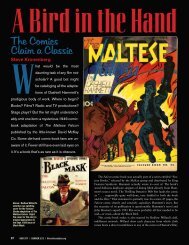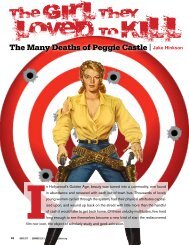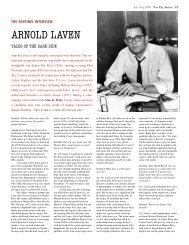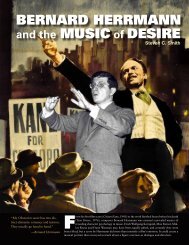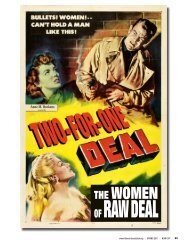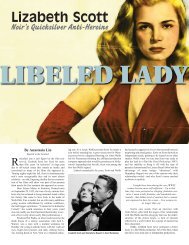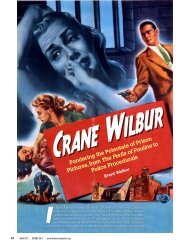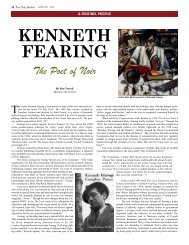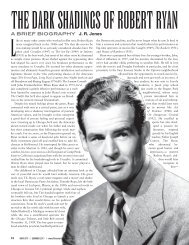The Forgotten Man - Film Noir Foundation
The Forgotten Man - Film Noir Foundation
The Forgotten Man - Film Noir Foundation
Create successful ePaper yourself
Turn your PDF publications into a flip-book with our unique Google optimized e-Paper software.
<strong>The</strong> ForgoTTen <strong>Man</strong><br />
Richard Fleischer’s RKO Years Jason Ney<br />
If you were to ask a group of film noir fans to come up with a single list of the best film noir directors of all time, a<br />
spirited debate would no doubt ensue. Those who prefer the big-ticket “A” pictures would put Billy Wilder and John<br />
Huston at the top. <strong>The</strong> low-rent, Poverty Row aficionados would argue passionately in favor of Edgar G. Ulmer and<br />
Anthony <strong>Man</strong>n. A few would loudly clamor for Sam Fuller. Ida lupino, the lone lady of the bunch, would surely get at<br />
least a handful of votes. Orson Welles fans would have intricately detailed arguments for why their guy deserved to be<br />
on the list. Others would argue in favor of Edward Dmytryk, Robert Wise, Nicholas Ray, Jacques Tourneur, and Robert<br />
Siodmak. Despite his debatable noir pedigree, Alfred Hitchcock would probably get at least a few mentions.<br />
However, there’s one name that probably wouldn’t come up often,<br />
if at all: Richard Fleischer.<br />
While Welles, Wilder, and other noir heavyweights continue to<br />
be celebrated and studied decades after their films were originally<br />
released, Fleischer remains noir’s forgotten man. Despite a successful<br />
directorial career that spanned nearly fifty years, he never managed<br />
to carry the same level of brand-name recognition that his<br />
more famous colleagues enjoyed. A perfect example of how Fleischer<br />
remains generally ignored in noir circles comes from the recent<br />
book <strong>Film</strong> <strong>Noir</strong>: <strong>The</strong> Directors, edited by Alain Silver and James<br />
45 noir citY i Winter 2012 i filmnoirfoundation.org<br />
Ursini. <strong>The</strong> book provides profiles of no less than twenty-eight noir<br />
directors, but Fleischer is nowhere to be found—except as the target<br />
of a quick brush-off in Silver’s introduction, who explains that<br />
Fleischer’s lack of inclusion is because he is “not necessarily” one<br />
of “the best examples” of a noir director. However, a fresh look at<br />
Fleischer’s accomplishments in the noir genre while under contract<br />
at RKO Radio Pictures in the late 1940s and early 1950s, reveals a<br />
consistently solid body of work that establishes him as a noir director<br />
worthy of more admiration and recognition than he currently<br />
receives.
Bill Williams and Marya Marco in <strong>The</strong> Clay Pigeon, Richard Fleischer's first noir<br />
WHEN DESCRIBING HOW HE BROKE INTO the picture<br />
business, Fleischer recalled that, during his time directing plays in<br />
New England, “An RKO talent scout named Arthur Willi caught<br />
one of the shows I’d directed, sought me out after the performance,<br />
and said, ‘Young man, how would you like to come to Hollywood<br />
and direct movies?’ Just like that. Even Cinderella never had it so<br />
good.” When he got to Hollywood in 1945, Sig Rogell, who, according<br />
to Fleischer, “was in charge<br />
of the B picture unit and ran it with<br />
all the humanity of a tyrant,” generously<br />
took Fleischer under his wing.<br />
By Fleischer’s own admission, Rogell<br />
could have crushed him. But instead,<br />
Rogell mentored him through his<br />
first years in Hollywood and, according<br />
to Fleischer, “turned me from a<br />
Yale Drama School graduate into a<br />
Hollywood survivor.”<br />
Fleischer didn’t immediately start<br />
out in noir, but it would quickly prove<br />
to be his salvation and his springboard<br />
into a long and successful career. His<br />
first picture for Rogell and the RKO<br />
“B” unit was the child-focused drama<br />
Child of Divorce (1946), starring<br />
the Shirley Temple wannabe Sharyn<br />
Moffett. Unlike most “B” pictures<br />
which, according to Fleischer, were<br />
never previewed but were instead<br />
simply “manufactured and dumped<br />
into the theatres owned by RKO,”<br />
his first film actually received a preview<br />
screening in Hollywood and was<br />
warmly received, both at its initial<br />
46 noir citY i SPrinG 2013 i filmnoirfoundation.org<br />
screening and when it was widely released on<br />
the second half of a double bill.<br />
But the initial glow didn’t last long.<br />
Banjo (1947), also starring Moffett, was<br />
an unmitigated disaster. It also received a<br />
preview screening in Westwood Village but<br />
this time, the theatergoers weren’t so kind.<br />
<strong>The</strong> theater was packed with college kids<br />
expecting to see a preview of a major studio<br />
release, not an RKO “B” picture about the<br />
adventures of a girl and her dog. According<br />
to Fleischer, when the name SHARYN<br />
MOFFETT flashed across the screen during<br />
the opening credits, “Pandemonium broke<br />
out. <strong>The</strong> entire audience rose to its feet and<br />
started pushing toward the aisles. <strong>The</strong>y were<br />
screaming ‘NO! NO! NO!’ at the screen.<br />
<strong>The</strong> ushers, three abreast, rushed into the<br />
aisles yelling, ‘You can’t get your money<br />
back after you’ve seen the title!’ and started<br />
pushing the surging crowd back. It was utter<br />
chaos.” When the film was finally released,<br />
audiences generally reacted the same way as<br />
the college kids. Everyone but Fleischer—<br />
Sharyn Moffett, producer Lillie Hayward, Banjo the dog—got fired.<br />
Fleischer managed to escape with his job, but his relationship with<br />
Rogell was seriously damaged. As he put it, “it was several months<br />
before Rogell would even speak to me.”<br />
NINETEEN FORTY-EIGHT WAS A PIvOTAL YEAR for both<br />
Fleischer and RKO. Fleischer needed to figure out a way to get back
Real-life husband and wife Bill Williams and Barbara Hale in <strong>The</strong> Clay Pigeon<br />
into Rogell’s good graces, and the studio was struggling through another<br />
tumultuous change in leadership. Richard B. Jewell writes in<br />
RKO Radio Pictures: A Titan is Born that “executive turnover was<br />
in fact the distinguishing feature of [RKO’s] twenty-nine year existence.…<br />
RKO’s management was never stable. New corporate<br />
presidents or production heads, or both, arrived every few years,<br />
making RKO the most unsettled and erratic of motion picture enterprises.”<br />
In May of 1948, the new executive was none other than<br />
Howard Hughes.<br />
While Hughes’ meddling, fickle actions would eventually spell<br />
doom for RKO, they actually had a mostly positive effect on<br />
Fleischer’s career. Within weeks of taking over, Hughes fired 1900<br />
of RKO’s 2500 employees, shelved the serious “so-called message<br />
pictures” that were either already completed or in production,<br />
and mandated that the studio focus its efforts on churning out<br />
films filled with sex and violence. For a director like Fleischer<br />
working in the “B” picture unit, that meant one thing—noir, noir,<br />
and more noir.<br />
Early in 1948, before Hughes bought a majority stake in RKO<br />
and while Fleischer and Rogell were still on the outs, Fleischer<br />
somehow convinced Rogell to hire Carl Foreman to develop<br />
the screenplay for an original noir story called <strong>The</strong> Clay Pigeon<br />
(1948), which Fleischer would direct. <strong>The</strong> film was the first to go<br />
into production at RKO under the Hughes regime, and it kicked<br />
off a five-year run of under-the-radar success for Fleischer in the<br />
noir genre. From 1948 to 1951, Fleischer would complete no<br />
less than seven noirs, six of them for RKO and one—Trapped<br />
(1949)—while on loan to Eagle-Lion.<br />
It wasn’t long before Fleischer regained his footing, bouncing<br />
back from the Banjo debacle by directing both <strong>The</strong> Clay Pigeon<br />
and Bodyguard in 1948 (although <strong>The</strong> Clay Pigeon wouldn’t be<br />
released until 1949). In both films, Fleischer shows his developing<br />
skill as a director by getting excellent performances from his lead<br />
players. <strong>The</strong> Clay Pigeon, an amnesia noir, tells the story of Jim<br />
Fletcher (Bill Williams), a World War II veteran who wakes up in<br />
a VA hospital with a spotty memory and a lump on the back of<br />
his head. He’s not sure why everyone is giving him dirty looks,<br />
and he definitely doesn’t know why another patient was trying<br />
to strangle him in his sleep. It’s not long before he overhears the<br />
47 noir citY i SPrinG 2013 i filmnoirfoundation.org<br />
doc and the nurse talking about how the government is charging him<br />
with treason. Fletcher isn’t going to stand for that. He’s sure he didn’t<br />
do it, even if he can’t remember what happened during his tour of<br />
duty in the Pacific <strong>The</strong>atre. So he busts out of the hospital and heads<br />
for his buddy Mark Gregory’s house. Mark’s not home, but his wife<br />
Martha (Barbara Hale) is. What Jim doesn’t know, and what Martha<br />
doesn’t tell him initially, is that Mark is dead and he’s the main<br />
suspect. However, Jim convinces her of his innocence in short order,<br />
and together, they set out to clear his name.<br />
Fleischer makes the most of what turned out to be an inspired<br />
bit of casting. Bill Williams and Barbara Hale were married from<br />
1946 until Williams’ passing in 1992, and Fleischer tapped into their<br />
real-life chemistry and effectively translated it to the big screen, putting<br />
the two leads into action as a B-picture equivalent of Bogie and<br />
Bacall. <strong>The</strong>ir back-and-forth banter reflects a genuine off-screen attraction,<br />
something Fleischer worked to his own advantage. <strong>The</strong> two<br />
leads of the film are thoroughly convincing as they grow increasingly<br />
fond of one another throughout the course of the story, and they<br />
form a bright spot in what could have otherwise been a perfunctory,<br />
straightforward affair.<br />
Who knows what Fleischer thought when he first heard that<br />
he’d be directing Lawrence Tierney in Bodyguard. One of the most
legendary tough guys in<br />
Hollywood, Tierney was<br />
best known for his violent<br />
persona onscreen and his<br />
violent actions offscreen.<br />
In addition to several reallife<br />
scrapes with the law,<br />
he was just coming off a<br />
series of bad-guy roles—<br />
murderer John Dillinger in<br />
Dillinger (1945), murderer<br />
Steve Morgan in <strong>The</strong> Devil<br />
Thumbs a Ride (1947)<br />
and murderer Sam Wild in<br />
Born to Kill (1947)—when<br />
the role of ex-cop-turnedprivate-detective<br />
Mike<br />
Carter became available.<br />
He probably jumped at the<br />
chance to play a good guy.<br />
Perhaps Fleischer tapped<br />
into what Tierney would<br />
later reveal in a late-career<br />
interview when he said, “I<br />
resented those pictures they<br />
put me in. I never thought<br />
of myself as that kind of<br />
guy. I thought of myself as<br />
a nice guy who wouldn’t<br />
do rotten things. I hated<br />
that character so much but<br />
I had to do it for the picture.”<br />
Fleischer embraced<br />
Tierney’s desire to display<br />
a better side, and it shows.<br />
<strong>The</strong> two of them worked<br />
together to infuse the character<br />
of Mike Carter with<br />
a rough but complex and<br />
sympathetic personality<br />
that makes the audience<br />
want to root for, instead of<br />
against, him. Yes, Carter<br />
gets kicked off the police force in the film’s opening scene for being<br />
a loose cannon, and yes, he gets into a scrape with his commanding<br />
officer before leaving. But through it all, Fleischer gets Tierney to<br />
consistently show that there’s a good guy underneath that rough-andtumble<br />
exterior.<br />
Fleischer’s combined efforts on Bodyguard and <strong>The</strong> Clay Pigeon<br />
showed that he was back on his game. Once both films opened to generally<br />
positive receptions, he improved his reputation at RKO enough that,<br />
not only was his job safe, he was about to become one of the busiest and<br />
most productive directors at the entire studio.<br />
BY 1949, RICHARD FLEISCHER’S STOCK was steadily rising.<br />
RKO’s was not. Hughes was one year into what film scholar<br />
Betty Lasky once described as his “systematic seven-year rape of<br />
RKO.” Hughes was notorious for wanting to screen every single pic-<br />
48 noir citY i SPrinG 2013 i filmnoirfoundation.org<br />
ture before approving it<br />
for release, which resulted<br />
in several problems.<br />
He often wanted to make<br />
changes to the endings<br />
of pictures that were already<br />
complete, causing<br />
interminable delays and<br />
skyrocketing production<br />
costs. In addition, he<br />
would frequently equivocate<br />
on his own changes,<br />
often ordering new<br />
changes to a picture that<br />
contradicted his previous<br />
statements. He also had<br />
no concept of time. <strong>Film</strong>s<br />
would sit for months in<br />
his screening room before<br />
he would get around<br />
to viewing them. <strong>Man</strong>y<br />
sat for over a year. This<br />
caused both production<br />
and distribution to grind<br />
to a halt, which drastically<br />
affected the studio’s<br />
bottom line. At the end<br />
of the year, RKO Radio<br />
Pictures reported a loss<br />
of $3,721,415—a precipitous<br />
fall from 1947’s<br />
$5,085,847 profit.<br />
However, Fleischer<br />
had the incredible good<br />
fortune of not having to<br />
deal with Hughes, either<br />
directly or indirectly. As<br />
he put it, in 1949, “While<br />
the studio was falling<br />
down around us, nothing<br />
seemed to affect the B<br />
picture unit. We steamed<br />
right along churning out<br />
our little movies with no interference from anyone. … Forty-three pictures<br />
had been planned for 1949. Only twelve were made, three of<br />
which were mine. Single-handedly I had directed 25 percent of RKO’s<br />
entire output.”<br />
Fleischer continued his run at the tables with Follow Me Quietly<br />
(1949). When looking back on this film, Fleischer said, “This is the<br />
film that, above all, increased my knowledge of the trade. I learned<br />
how to organize a film.” While both <strong>The</strong> Clay Pigeon and Bodyguard<br />
were solid films in their own rights, Fleischer’s continuously improving<br />
directorial skill is evident in this one-hour police procedural, particularly<br />
since he managed to take an incredibly hokey premise and turn<br />
it into an entertaining outing. A serial killer who calls himself “<strong>The</strong><br />
Judge” has been murdering people for months, strangling them only<br />
on rainy nights. He leaves notes that are made out of letters cut from<br />
magazines that claim he is punishing sinners and meting out justice.
William Lundigan and Jeff Corey on the hunt for the murderous "Judge" in Fleischer's superb Follow Me Quietly<br />
<strong>The</strong> two cops on the case, Lt. Harry Grant (William Lundigan) and<br />
his wisecracking sidekick Sgt. Art Collins (Jeff Corey) are sitting on<br />
several pieces of evidence that they just can’t seem to piece together. In<br />
addition, Grant’s own lack of progress is driving him crazy. Grant is<br />
also trying to fend off a bunch of nagging questions from Ann Gorman<br />
(Dorothy Patrick), a doggedly persistent reporter for Four Star<br />
Crime, a lower-than-low tabloid rag.<br />
<strong>The</strong>n, one day when Grant is staring at all of the evidence they’ve<br />
compiled, he gets an idea. Instead of just sending out the standard,<br />
blasé description of what they think <strong>The</strong> Judge might look like, why<br />
not make a faceless but life-size dummy of him based on what they<br />
<strong>The</strong> life-size dummy that aids the cops in nailing a serial killer: Follow Me Quietly<br />
49 noir citY i SPrinG 2013 i filmnoirfoundation.org<br />
know? <strong>The</strong> idea is a hit within the department. <strong>The</strong>y bring in all the<br />
cops and let them see it. <strong>The</strong>y stand potential perps next to it in the<br />
lineup room to see how they measure up. <strong>The</strong>y take pictures of it<br />
from various angles and canvass the neighborhoods where the crimes<br />
were committed to see if anyone recognizes him.<br />
<strong>The</strong> entire premise is ludicrous. But it’s a testament to Fleischer’s<br />
ability as a director that the film holds together so well and even<br />
exhibits some nice stylistic flourishes. <strong>The</strong> rain-soaked night scenes<br />
are beautifully shot, and Fleischer gets effectively flashy with some<br />
appropriately deployed Dutch angles during the police’s canvassing<br />
operation. Because of Fleischer’s assured hand, the serial killer-asdummy<br />
approach comes across as genuinely creepy instead of hopelessly<br />
ridiculous. And with a 59 minute running time, the film moves<br />
along at a nice, brisk pace, never getting bogged down in unnecessary<br />
subplots or meandering character moments. With Follow Me<br />
Quietly, Fleischer had gained the confidence he needed to make a<br />
genuine noir classic. <strong>The</strong> right pieces just needed to come together,<br />
and in 1950, they did.<br />
THE COPYRIGHT DATE ON <strong>The</strong> Narrow Margin reads MC-<br />
MLII. It’s a simple date. 1952. During the opening credits, it quickly<br />
flashes by on the bottom of the screen, and most viewers probably<br />
don’t even notice it. But there is a story behind why that date is 1952<br />
instead of 1951 or 1950, a story that is as interesting as it is bizarre.<br />
It is, if nothing else, a story that epitomizes the Howard Hughes era<br />
at RKO.<br />
In 1950, Fleischer was continuing his upward trajectory with his<br />
fourth RKO noir, Armored Car Robbery. <strong>The</strong> film stars Charles Mc-<br />
Graw, a man whom William Friedkin calls “the quintessential B picture<br />
film noir actor.” Friedkin sums up McGraw’s on-screen persona
when he describes him as “the most hard boiled of the tough guys.”<br />
McGraw, who was a contract player for RKO and appeared in many<br />
“B” noirs during the late 1940s and early 1950s, had a face cut from<br />
granite, the leftover pieces of which were dumped down his throat and<br />
left to chafe against his vocal cords. He was the perfect fit for the type<br />
of character he played in Armored Car Robbery: a hard-nosed cop out<br />
for blood after a gang of thugs<br />
botches—you guessed it—an<br />
armored car robbery, offing<br />
his partner in the process. <strong>The</strong><br />
film boasts great performances,<br />
excellent nighttime cinematography,<br />
a stripped-down, fastmoving<br />
plot, and a fantastic<br />
final scene that preceded a similar<br />
ending in Stanley Kubrick’s<br />
noir classic <strong>The</strong> Killing (1956).<br />
But it wasn’t Armored Car<br />
Robbery that was destined to<br />
put Fleischer on the map. He<br />
reteamed with McGraw in<br />
1950, and once he completed<br />
directing <strong>The</strong> Narrow Margin<br />
in just thirteen days, he knew<br />
he had something special. As<br />
he put it, “everyone who saw<br />
50 noir citY i SPrinG 2013 i filmnoirfoundation.org<br />
Adele Jergens, Don McGuire, and William Talman in a tense moment from<br />
Armored Car Robbery<br />
<strong>Noir</strong> icon Charles McGraw commands a police battalion in the climax of Armored Car Robbery<br />
it at the studio was convinced it was my breakthrough film.” And<br />
it would be. But not in 1950, and not in 1951. As Fleischer put it,<br />
in 1950, the film “came to the attention of Howard Hughes, who<br />
promptly put it in his projection booth, where it sat for more than<br />
a year.” His improbable run of autonomy had finally come to an<br />
end. He’d run up against the one-man wrecking crew who was unintentionally,<br />
but systematically,<br />
destroying RKO.<br />
WHEN HUGHES FINALLY<br />
DID GET around to watching<br />
the film, he loved it. He<br />
watched it several times, and<br />
came away from it claiming it<br />
was his favorite film. But in the<br />
world of Howard Hughes, this<br />
enthusiasm didn’t result in the<br />
typical, logical route for such<br />
a film—heavy promotion followed<br />
by a splashy release. It<br />
meant something else entirely.<br />
Because Hughes loved the<br />
film so much, he strongly considered<br />
scrapping it entirely.<br />
His plan, which would have<br />
guaranteed that Fleischer’s
51 noir citY i SPrinG 2013 i filmnoirfoundation.org
Charles McGraw and Marie Windsor stare each other down in Fleischer's masterpiece, <strong>The</strong> Narrow Margin<br />
masterpiece would never be released, would ditch the film Fleischer<br />
made and turn the story into an “A” vehicle for Robert Mitchum<br />
and Jane Russell, both of whom were shooting His Kind of Woman<br />
(1951) at the time. <strong>The</strong> budget would jump from $230,000 to<br />
$1,000,000, and Hughes would have probably assigned one of his<br />
“A” picture directors to it.<br />
Fleischer described this time in his life as exasperating. “For years<br />
I’d been frustratingly close to making the switch to A pictures,” he<br />
said. “I’d been promised my big break over and over again, but it always<br />
eluded me because of the revolving-door procession of various<br />
heads of production. <strong>The</strong>y were the only ones who could bring about<br />
such a change, but none of them ever stayed long enough to do so.”<br />
During the time that <strong>The</strong> Narrow Margin was stuck in limbo, one<br />
of the production heads that left was Fleischer’s mentor Sid Rogell,<br />
whom Hughes fired. Hughes was continuously calling Rogell in the<br />
middle of the night to discuss minute production details, and when<br />
Rogell finally had enough of it and told Hughes off, he got canned<br />
the next day. No one was left to champion Fleischer’s cause.<br />
Things quickly went from bad to worse. “I’d finally gotten my<br />
foot on the bottom rung of the ladder that would help me climb out<br />
of the B picture pit,” Fleischer recalled, “and I wasn’t about to slip<br />
back in.” So when his new boss handed him a script that, according<br />
to Fleischer, “had nothing going for it except schlock,” he handed it<br />
back and refused to make it. For a contract director under the studio<br />
system, this almost certainly meant career suicide. And Fleischer<br />
52 noir citY i SPrinG 2013 i filmnoirfoundation.org<br />
came close. He got suspended without pay, putting his job in serious<br />
jeopardy.<br />
In a move of sheer desperation, he wrote a letter to Howard<br />
Hughes, explaining his situation. And Hughes, who was responsible<br />
for Fleischer’s predicament in the first place, actually came up with a<br />
solution that worked for both of them. Fleischer agreed to work with<br />
Hughes to fix what Hughes saw as a problematic ending to His Kind<br />
Of Woman, which had wrapped shooting months before. In return,<br />
Hughes would retroactively lift Fleischer’s suspension, release <strong>The</strong><br />
Narrow Margin without any changes, and allow Fleischer’s contract<br />
to expire in 1952.<br />
WHEN <strong>The</strong> Narrow MargiN WAS finally released, it opened<br />
to nearly universal critical acclaim. Time magazine packed their entire<br />
Cinema section with a glowingly positive review and a lengthy profile<br />
of Fleischer and the film’s producer, Stanley Rubin, calling them<br />
“Hollywood’s bright new hopes for the future.” <strong>The</strong> New York Times<br />
wrote that the film “should glue anyone to the edge of his seat and<br />
prove, once and for all, that a little can be made to count for a lot.”<br />
And in <strong>The</strong> RKO Story, Richard B. Jewell writes that the film is “one<br />
of the best in the studio’s history.”<br />
<strong>The</strong> film deserved every accolade it received. Fleischer took the<br />
skills he had developed in the “B” picture unit at RKO and expertly<br />
applied them to <strong>The</strong> Narrow Margin. <strong>The</strong> film follows a cop played<br />
by McGraw who needs to get a mob wife from Chicago to L.A. so
that she can testify in front of a grand jury about her ex-husband’s<br />
misdeeds. <strong>The</strong> majority of the film takes place on a locomotive, the<br />
speed of the train matching the speed at which the exciting and unpredictable<br />
plot unfolds. <strong>The</strong> film is memorable for the deep, dark<br />
shadows in the opening scenes, the innovative handheld camerawork<br />
that highlights and enhances the train’s claustrophobic atmosphere,<br />
the gritty, hard-as-nails performances from both McGraw and Marie<br />
Windsor as the mob wife, and the third-act twist that underscores a<br />
fundamental noir theme: nothing is as it seems. All of these elements<br />
combine beautifully to create one of the classics of the genre. With<br />
the release of <strong>The</strong> Narrow Margin, Fleischer could finally climb out<br />
of the “B” noir pit and into the “A” picture arena.<br />
AFTER THE SUCCESS OF <strong>The</strong> Narrow Margin, Fleischer moved<br />
on to direct bigger films, such as the Disney adventure classic 20,000<br />
Leagues Under the Sea (1954), the courtroom drama Compulsion<br />
(1959) and the science fiction thrillers Fantastic Voyage (1966) and<br />
Soylent Green (1973). And while some of his later films such as Violent<br />
Saturday (1955) and 10 Rillington Place (1971) contain some<br />
noir elements, Fleischer never directed another true film noir.<br />
Unfortunately, critics and audiences were just as ready to move<br />
on from Fleischer’s “B” noirs as he was. While many classic and even<br />
lesser-known noirs made their way onto VHS in the 1980s, Laserdisc<br />
in the 1990s and DVD in the late 90s/early 2000s, Fleischer’s noirs<br />
(with the exception of <strong>The</strong> Narrow Margin, which has received several<br />
home video releases) were mostly left neglected and unavailable<br />
until Warner Bros., which owns a significant portion of the RKO<br />
library, started belatedly releasing his films on DVD. <strong>The</strong> Narrow<br />
Margin was released in 2005. His Kind of Woman was released in<br />
2006. However, even though Fleischer ended up directing the bulk<br />
of the final product, his work remains uncredited. Armored Car Robbery<br />
wasn’t released until 2010. Follow Me Quietly and Bodyguard<br />
were never released in any home video format until their made-ondemand<br />
DVD-R releases through the Warner Archive Collection in<br />
2011. While <strong>The</strong> Clay Pigeon has received a DVD release in Spain,<br />
it is still unavailable in any home video format in the United States.<br />
Bathed in smoke and light, Charles McGraw prepares to go to work in <strong>The</strong> Narrow Margin<br />
53 noir citY i SPrinG 2013 i filmnoirfoundation.org<br />
A fine portrait of Marie Windsor, memorable in <strong>The</strong> Narrow Margin<br />
In essence, all but <strong>The</strong> Narrow Margin were quickly forgotten,<br />
written off as nothing more than low-budget movies made for a<br />
quick buck to fill space on the bottom half of a double bill. Nothing<br />
epitomizes this prevailing attitude toward<br />
Fleischer’s work than Fleischer himself. <strong>The</strong><br />
only noir he covers in any detail in Just Tell Me<br />
When to Cry, his 1993 memoir, is <strong>The</strong> Narrow<br />
Margin. <strong>The</strong> majority of his other noirs<br />
don’t even get a passing mention. When Eddie<br />
Muller hosted a film noir festival in 1999<br />
with Fleischer as a special guest, he reportedly<br />
dreaded watching Armored Car Robbery for<br />
the first time since its initial release in 1950.<br />
His response when the film finished screening:<br />
“It holds up; I’m amazed.”<br />
But looking back on all of Fleischer’s RKO<br />
noirs, one common denominator is evident. All<br />
of his noirs are entertaining. His cheap, onehour<br />
programmers (with the exception of the<br />
“A” picture His Kind of Woman, his longest<br />
film is <strong>The</strong> Narrow Margin, which clocks in<br />
at 71 minutes) might not have been made for<br />
much, but they consistently deliver the goods.<br />
In his initial noir outing (<strong>The</strong> Clay Pigeon),<br />
Fleischer showed that he had a knack for craft-
Jacqueline White and Charles McGraw running and hiding in the climax of <strong>The</strong> Narrow Margin<br />
ing an entertaining story that featured some genuinely creative directorial<br />
choices. Just take a look at the chase scene early in the film.<br />
Fleischer eschews the typical, cheap process shots used in most “B”<br />
films in favor of several dramatic viewpoints, using cameras mounted<br />
on the backs of production trucks that were speeding along with<br />
the chase’s cars. That creativity continued in all of his noirs leading<br />
up to <strong>The</strong> Narrow Margin, where it finally blossomed into something<br />
iconic.<br />
In addition to the seven noirs he worked on from 1948 to 1951,<br />
Fleischer also directed two non-noirs: So This is New York (1948)<br />
and Make Mine Laughs (1949). Such a workload would have burnt<br />
out a lesser director. However, Fleischer managed to successfully<br />
complete all of his assignments during that time. He also avoided<br />
making a bad noir—quite a feat, given some of the source material.<br />
<strong>The</strong> “B” noir subgenre is littered with dozens, if not hundreds,<br />
of generic crime pictures that have no drive, no spark, and no true<br />
entertainment value. But Fleischer’s work at RKO transcended its<br />
humble place of origin by being consistently engaging and enjoyable.<br />
Even though he once referred to the “B” picture unit at RKO as “the<br />
ooze I’d clawed my way out of,” the films he made tell a different<br />
story. He was clearly a director having a good time. <strong>The</strong> half-dozen<br />
noirs he made for RKO, when compared against the work of betterknown<br />
noir filmmakers, convincingly demonstrate that his name deserves<br />
a place on those “best noir directors” lists. Here’s hoping that<br />
it happens sooner rather than later. After all, it’s only about sixty<br />
years overdue. ■<br />
54 noir citY i SPrinG 2013 i filmnoirfoundation.org<br />
Works Cited<br />
Fleischer, Richard. Just Tell Me When to Cry: A Memoir. New York:<br />
Carroll & Graf, 1993.<br />
Follow Me Quietly. Dir. Richard Fleischer. Warner Bros., 2011. DVD.<br />
Friedkin, William. “Commentary Track.” <strong>The</strong> Narrow Margin. Dir.<br />
Richard Fleischer. Warner Bros, 2005. DVD.<br />
Jewell, Richard B., with Vernon Harbin. <strong>The</strong> RKO Story. New York:<br />
Arlington House, 1982.<br />
Jewell, Richard B. RKO Radio Pictures: A Titan is Born. Berkeley:<br />
Univ. of California P., 2012.<br />
Lasky, Betty. RKO: <strong>The</strong> Biggest Little Major of <strong>The</strong>m All. Englewood<br />
Cliffs: Prentice-Hall. 1984.<br />
“Movie Review: <strong>The</strong> Narrow Margin.” <strong>The</strong> New York Times, accessed<br />
Nov. 16, 2012. Web.<br />
Silver, Alain, and James Ursini, eds. <strong>Film</strong> <strong>Noir</strong>: <strong>The</strong> Directors. Milwaukee,<br />
WI: Limelight Ed. 2012.<br />
Vallance, Tom. “Lawrence Tierney: Obituary.” <strong>The</strong> Independent.<br />
March 1, 2002.



